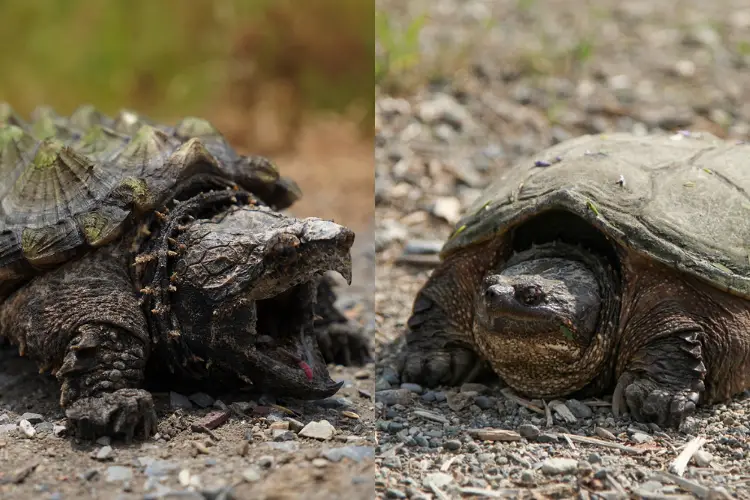Types of Snapping Turtles
There are two species of snapping turtles namely the alligator snapping turtle and the common snapping turtle. While the former is labeled as a vulnerable species, the latter is of the least concern and is widely distributed across all 50 states.
Alligator snapping turtles are also bigger compared to common snapping turtles. However, both animals can turn aggressive if they feel threatened, so you should handle them with care.
This guide discusses more details about the snapping turtle species. For each turtle, you’ll learn the basics such as physical appearance, average adult size, habitat, diet, conservation status, and more.
1. Alligator Snapping Turtle

- Scientific name: Macroclemys temminckii
- Common name: Alligator snapping turtle, Snapping turtle
- Family: Chelydridae
- Size: 15 to 26 inches
- Lifespan: 80 to 120 years
- Conservation status: Vulnerable
The alligator snapping is large than the common snapping turtle. An adult alligator snapping turtle weighs 15 to 20 inches long.
An alligator turtle is characterized by a long, tough shell with trigonal ridges that resemble the back of an alligator (hence the name alligator turtle). Shell coloring can be black, olive, or brown.
Though some people believe that the green tips on the shell ridges are natural, they’re simply algae.
These alligator turtles also prefer living in deeper waters of rivers, canals, lakes, and swamps.
As omnivorous species, they hunt their prey (but not actively). They have a unique way of hunting where they lie at the bottom of the water body and open their mouth to show their pink work-like appendage to lure their prey.
And when the prey gets close enough, the turtle ambushes it!
Another interesting fact about this turtle is its powerful jaws which can bite with a force of up to 1000lbs!
This makes them extremely dangerous turtles and should NEVER be handled in the wild! Mind you, they have injured even the most experienced herpetologists with their bites.
2. Common Snapping Turtle

- Scientific name: Chelydra serpentina
- Common name: Snapping Turtle
- Family: Chelydridae
- Size: 8 to 18 1/2 inches
- Lifespan: 30 to 50 years or more
- Conservation status: Least Concern
Common snapping turtles are widespread throughout the US and are present in nearly all 50 states.
An average adult is pretty large and has a shell length of 18½ inches long. This species has a chunky head, a long tail, and large webbed feet. The shell color is black or olive and has no distinct pattern.
These snapping turtles are known for their powerful jaws—they’re so strong that these turtles eat other turtles!
You’ll find them in waterbodies with muddy bottoms. Examples include marshes, ponds, lakes, rivers, and even shallow streams. They generally prefer waters with aquatic vegetation in plenty and foods such as fish, frogs, birds, etc.
These turtles generally show docile behavior but can get quite aggressive if taken out of water. The best way to calm it is to take it back to the waters, where it feels safe.
Conclusion
These are the two species of turtles that fall under the Snapping Turtles family. While the two may have some clear-cut differences in size and appearance, they have many similar differences such as choice of habitat and almost similar diet.
However, keep in mind that these turtles can become aggressive if they feel threatened. And you should always handle them with great care. Also, the alligator turtle is vulnerable and may not be easier to come by compared to the common snapping turtles which are present in pretty much every state.


